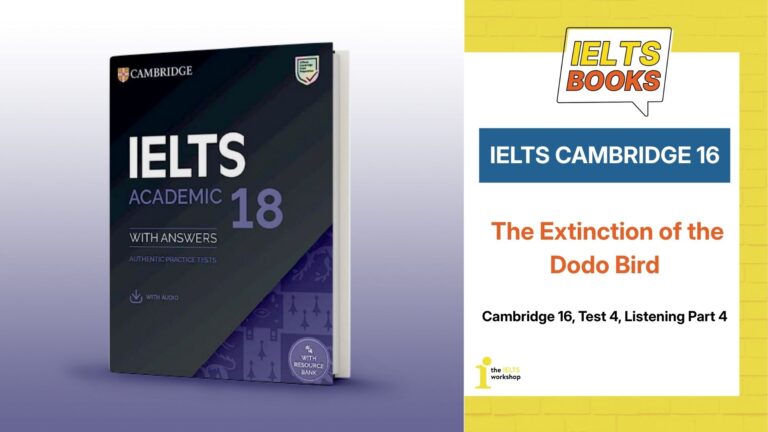Bạn đang băn khoăn luyện tập mãi không nâng được band điểm IELTS? Kĩ năng Listening trong IELTS có đang làm khó bạn? Đừng lo, The IELTS Workshop biên soạn đáp án và lời giải chi tiết bởi đội ngũ giáo viên giàu kinh nghiệm sẽ giúp bạn nâng cao trình độ tiếng anh hiệu quả thông qua IELTS Cambridge 16, Test 4, Listening Part 4: The Extinction of the Dodo Bird.
1. Đáp án IELTS Cambridge 16 Test 4 Listening Part 4
| Câu hỏi | Đáp án |
| 31 | spices |
| 32 | colony |
| 33 | fat |
| 34 | head |
| 35 | movement |
| 36 | balance |
| 37 | brain |
| 38 | smell |
| 39 | rats |
| 40 | forest |
2. Transcript và bản dịch chi tiết IELTS Cambridge 16 Test 4 Listening Part 4
Transcript
One of the most famous cases of extinction is that of a bird known as the dodo. In fact there’s even a saying in English, ‘as dead as the dodo’, used to refer to something which no longer exists. But for many centuries the dodo was alive and well, although it could only be found in one place, the island of Mauritius in the Indian Ocean.
It was a very large bird, about one metre tall, and over the centuries it had lost the ability to fly, but it survived happily under the trees that covered the island.
Then in the year 1507 the first Portuguese ships stopped at the island. The sailors were carrying spices back to Europe, and found the island a convenient stopping place where they could stock up with food and water for the rest of the voyage, but they didn’t settle on Mauritius.
However, in 1638 the Dutch arrived and set up a colony there. These first human inhabitants of the island found the dodo birds a convenient source of meat, although not everyone liked the taste.
Early accounts described the dodo as slow and clumsy, but recent studies—looking at the skeleton—suggest it was actually capable of quite rapid movement, and its small wings were probably used for balance when moving over uneven ground. Analysis of the skull has shown that the brain was average in size and its sense of smell was well-developed, helping it locate ripe fruit and food hidden in thick vegetation.
The disappearance of the dodo was not solely due to hunting. Sailors introduced dogs and monkeys that ate their fruit diet—and rats, accidentally brought by ships, ravaged the island and consumed the eggs, devastating their population. Finally, when agriculture arrived, the forest that once covered the island was cleared to make way for crops like sugar, eliminating the dodo’s habitat and leading to its sudden extinction.
Dịch tiếng Việt
Một trong những trường hợp tuyệt chủng nổi tiếng nhất là loài chim gọi là dodo. Thậm chí còn có câu thành ngữ trong tiếng Anh: “as dead as the dodo” (“chết như dodo”), dùng để chỉ thứ gì đó hoàn toàn biến mất. Tuy nhiên trong nhiều thế kỷ, dodo vẫn tồn tại và khỏe mạnh, mặc dù chỉ sống ở một nơi – đảo Mauritius ở Ấn Độ Dương.
Đây là loài chim rất lớn, cao khoảng 1 mét, và theo thời gian mất khả năng bay, nhưng vẫn sinh sống thoải mái dưới tán rừng trên đảo.
Năm 1507, những chiếc tàu đầu tiên của Bồ Đào Nha dừng tại đảo. Thủy thủ mang theo các loại gia vị (spices) để về Châu Âu và coi đây là điểm dừng tiện lợi để tiếp tế thực phẩm và nước, mặc dù họ không định cư tại đó.
Tuy nhiên, năm 1638, người Hà Lan đến và thiết lập một thuộc địa (colony). Người đầu tiên sống trên đảo đã xem dodo là nguồn thịt sẵn, dù không phải ai cũng thích hương vị của nó.
Những mô tả sớm mô tả dodo chậm chạp và vụng về, nhưng các nghiên cứu gần đây—dựa trên bộ xương—chỉ ra rằng nó thực ra có thể di chuyển khá nhanh, và đôi cánh nhỏ của nó được sử dụng để giữ thăng bằng (balance) khi đi trên mặt đất gồ ghề. Phân tích hộp sọ cho thấy bộ não (brain) của nó ở mức trung bình và giác quan về khứu giác (smell) phát triển, giúp nhận diện trái chín hoặc thức ăn trong tán rừng dày.
Sự tuyệt chủng của dodo không chỉ do bị săn bắt. Thủy thủ mang theo chó và khỉ—loài khỉ ăn thức ăn mà dodo dựa vào—và đặc biệt là chuột (rats) được đưa sang đảo tình cờ, đã xâm lược và ăn trứng dodo, ảnh hưởng nặng nề đến số lượng. Cuối cùng, khi nông nghiệp (agriculture) xuất hiện, toàn bộ rừng (forest) trên đảo bị chặt để trồng cây trồng như mía, loại bỏ môi trường sống của dodo, dẫn đến sự biến mất đột ngột của loài này.
Phân tích chi tiết đáp án Cambridge 18 Test 4 – Listening Part 4: The Extinction of the Dodo Bird
Câu 31
Đáp án: spices
Transcript: In 1507, the first Portuguese ships stopped at the island. The sailors, who were transporting spices back to Europe, found the island a convenient stopping point to replenish food and water.
Phân tích: Dựa vào mốc thời gian 1507 và từ khóa “Portuguese ships”, ta xác định được vị trí thông tin. Bài nghe cho biết các tàu Bồ Đào Nha chở spices (gia vị) dừng lại để tiếp tế.
Gợi ý trong bài: “sailors… transporting spices”
Câu 32
Đáp án: colony
Transcript: In 1638, the Dutch arrived and set up a colony on the island…
Phân tích: Câu hỏi yêu cầu xác định thứ được người Hà Lan thiết lập năm 1638. Từ “establish” trong câu hỏi tương đương với “set up” trong bài nghe. Đáp án là “colony”.
Gợi ý trong bài: “set up a colony”
Câu 33
Đáp án: fat
Transcript: The best-known picture is a Dutch painting where the bird appears to be extremely fat…
Phân tích: Từ khóa “painting” trong câu hỏi được paraphrase thành “picture”. Đáp án cần là đặc điểm hình dáng chim dodo trong tranh – “fat”.
Gợi ý trong bài: “appears to be extremely fat”
Câu 34
Đáp án: head
Transcript: There are four preserved parts of the bird recorded in the early 17th century, but only the head survived…
Phân tích: Đáp án cần là bộ phận còn lại duy nhất của chim dodo – chính là “head”.
Gợi ý trong bài: “only the head survived”
Câu 35
Đáp án: movement
Transcript: Early accounts described the dodo as slow and clumsy, but scientists now believe its strong knee joints suggest it was capable of surprisingly fast movement.
Phân tích: Câu hỏi hỏi về khả năng “rapid movement” của chim dodo. Dù ban đầu bị đánh giá là chậm chạp, nhưng nghiên cứu chỉ ra nó có thể di chuyển nhanh.
Gợi ý trong bài: “fast movement”
Câu 36
Đáp án: balance
Transcript: Its small wings wouldn’t have enabled it to fly, but they probably helped it to maintain balance on uneven ground.
Phân tích: Cánh nhỏ không giúp dodo bay, nhưng dùng để giữ balance (thăng bằng) khi di chuyển trên địa hình gồ ghề.
Gợi ý trong bài: “helped to maintain balance”
Câu 37
Đáp án: brain
Transcript: They found that, contrary to earlier beliefs, the dodo’s brain was actually average in size.
Phân tích: Đáp án là bộ phận có kích cỡ trung bình – “brain”. Điều này phủ nhận ý kiến trước đó rằng dodo kém thông minh.
Gợi ý trong bài: “brain was average in size”
Câu 38
Đáp án: smell
Transcript: The structure of its skull suggested that one sense, in particular, was highly developed – its sense of smell.
Phân tích: Câu hỏi hỏi về giác quan giúp dodo tìm thức ăn. Bài nghe chỉ ra rằng khứu giác smell rất phát triển.
Gợi ý trong bài: “sense of smell… highly developed”
Câu 39
Đáp án: rats
Transcript: The ships also introduced rats, which escaped and spread across the island. They posed a serious threat by consuming the dodo’s eggs.
Phân tích: Đáp án cần là loài vật đã ăn trứng dodo – đó là rats (chuột).
Gợi ý trong bài: “rats… consuming the dodo’s eggs”
Câu 40
Đáp án: forest
Transcript: The island was once entirely covered by forest, providing the ideal habitat for the dodo, but much of it was cut down to grow crops like sugar.
Phân tích: Đáp án là thứ đã bị phá hủy – “forest”. Rừng bị đốn để trồng cây, làm mất môi trường sống của dodo.
Gợi ý trong bài: “forest… was cut down”
4. Series giải đề IELTS Cambridge 16
- [PDF + Audio] Sách IELTS Cambridge 16
- Đáp án Cambridge 16 & Lời giải chi tiết: Test 1 – Test 4
- Giải chi tiết Cambridge 16, Test 4, Listening Part 1: Holiday rental
- Giải IELTS Cambridge 16 Test 4 Listening Part 2: Local council report on traffic and highways
- Giải IELTS Cambridge 16 Test 4 Listening Part 3: City bike-sharing schemes
- Giải Cambridge IELTS 16 Test 4 Reading Passage 1: Roman tunnels
- Giải Cambridge IELTS 16 Test 4 Reading Passage 2: Changes in reading habits
- Giải Cambridge IELTS 16 Test 4 Reading Passage 3: Attitudes towards Artificial Intelligence
- [PDF + Audio] Trọn bộ Cambridge Practice Tests For IELTS 1 – 20 mới nhất
Đừng bỏ lỡ cơ hội học IELTS MIỄN PHÍ cùng các thầy cô 9.0 tại The IELTS Workshop – nơi bạn sẽ được trang bị đầy đủ phương pháp học và kỹ năng làm bài thi hiệu quả nhé!



![[PDF + Audio] Trọn bộ Cambridge Practice Tests For IELTS 1 – 20 mới nhất](https://onthiielts.com.vn/wp-content/uploads/2020/04/cam-1-14-764x400.jpg)
![[PDF + Audio] Cambridge IELTS 20: Cập nhật mới nhất (Bản đẹp)](https://onthiielts.com.vn/wp-content/uploads/2025/07/Cambridge-IELTS-20-300x169.jpg)




